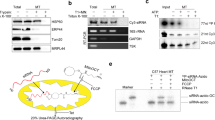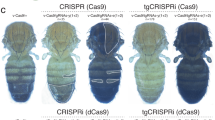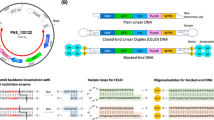Abstract
In many eukaryotes, expression of nuclear-encoded mRNA can be strongly inhibited by the presence of a double-stranded RNA (dsRNA) corresponding to exon sequences in the mRNA (refs 1,2). The use of this “RNA interference” (RNAi) in mammalian studies had lagged well behind its utility in lower animals because uninterrupted RNA duplexes longer than 30 base pairs trigger generalized cellular responses through activation of dsRNA-dependent protein kinases3. Recently it was demonstrated4 that RNAi can be made to work in cultured human cells by introducing shorter, synthetic duplex RNAs (∼20 base pairs) through liposome transfection. We have explored several strategies for expressing similar short interfering RNA (siRNA) duplexes within cells from recombinant DNA constructs, because this might allow long-term target-gene suppression in cells, and potentially in whole organisms. Effective suppression of target gene product levels is achieved by using a human U6 small nuclear RNA (snRNA) promoter to drive nuclear expression of a single RNA transcript. The siRNA-like parts of the transcript consists of a 19–base pair siRNA stem with the two strands joined by a tightly structured loop and a U1–4 3′ overhang at the end of the antisense strand. The simplicity of the U6 expression cassette and its widespread transcription in human cell types suggest that this mode of siRNA delivery could be useful for suppressing expression of a wide range of genes.
This is a preview of subscription content, access via your institution
Access options
Subscribe to this journal
Receive 12 print issues and online access
$209.00 per year
only $17.42 per issue
Buy this article
- Purchase on Springer Link
- Instant access to full article PDF
Prices may be subject to local taxes which are calculated during checkout



Similar content being viewed by others
References
Zamore, P.D. RNA interference: listening to the sound of silence. Nat. Struct. Biol. 8, 746–750 (2001).
Bernstein, E., Denli, A.M. & Hannon, G.J. The rest is silence. RNA 7, 1509–1521 (2001).
Gil, J. & Esteban, M. Induction of apoptosis by the dsRNA-dependent protein kinase (PKR): mechanism of action. Apoptosis 5, 107–114 (2000).
Elbashir, S.M. et al. Duplexes of 21-nucleotide RNAs mediate RNA interference in cultured mammalian cells. Nature 411, 494–498 (2001).
Good, P.D. et al. Expression of small, therapeutic RNAs in human cell nuclei. Gene Ther. 4, 45–54 (1997).
Bertrand, E. et al. The expression cassette determines the functional activity of ribozymes in mammalian cells by controlling their intracellular localization. RNA 3, 75–88 (1997).
Cheong, C., Varani, G. & Tinoco, I. Jr. Solution structure of an unusually stable RNA hairpin, 5′-GGAC(UUCG)GUCC. Nature 346, 680–682 (1990).
Elbashir, S.M., Lendeckel, W. & Tuschl, T. RNA interference is mediated by 21- and 22-nucleotide RNAs. Genes Dev. 15, 188–200 (2001).
Nykänen, A., Haley, B. & Zamore, P.D. ATP requirements and small interfering RNA structure in the RNA interference pathway. Cell 107, 309–321 (2001).
Lipardi, C., Wei, Q. & Paterson, B.M. RNAi as random degradative PCR: siRNA primers convert mRNA into dsRNAs that are degraded to generate new siRNAs. Cell 107, 297–307 (2001).
Chatterjee, S., Johnson, P.R. & Wong, K.K. Jr. Dual-target inhibition of HIV-1 in vitro by means of an adeno-associated virus antisense vector. Science 258, 1485–1488 (1992).
Kunkel, G.R., Maser, R.L., Calvet, J.P. & Pederson, T. U6 small nuclear RNA is transcribed by RNA polymerase III. Proc. Natl. Acad. Sci. USA 83, 8575–8579 (1986).
Kunkel, G.R. & Pederson, T. Upstream elements required for efficient transcription of a human U6 RNA gene resemble those of U1 and U2 genes even though a different polymerase is used. Genes Dev. 2, 196–204 (1988).
Danzeiser, D.A., Urso, O. & Kunkel, G.R. Functional characterization of elements in a human U6 small nuclear RNA gene distal control region. Mol. Cell. Biol. 13, 4670–4678 (1993).
Acknowledgements
This work was supported by NIH grant AI40936 to D.R.E. and the Medical Scientist Training Program at the University of Michigan. We thank Gary R. Kunkel for the cloned, human U6 snRNA gene, and Michael Imperiale and Eric Fearon for other materials.
Author information
Authors and Affiliations
Corresponding author
Ethics declarations
Competing interests
D.R.E., C.P.P., and P.D.G have filed a patent application for expression of si-like RNAs in mammalian cells using U6 promoter cassettes, entitled “Intracellular Expression and Delivery of siRNAs in Mammalian Cells.”
Rights and permissions
About this article
Cite this article
Paul, C., Good, P., Winer, I. et al. Effective expression of small interfering RNA in human cells. Nat Biotechnol 20, 505–508 (2002). https://doi.org/10.1038/nbt0502-505
Received:
Accepted:
Issue Date:
DOI: https://doi.org/10.1038/nbt0502-505
This article is cited by
-
RNA-based translation activators for targeted gene upregulation
Nature Communications (2023)
-
Efficient in vitro and in vivo RNA editing via recruitment of endogenous ADARs using circular guide RNAs
Nature Biotechnology (2022)
-
Biotechnological and Therapeutic Applications of Natural Nucleic Acid Structural Motifs
Topics in Current Chemistry (2020)
-
In Vivo Gene Silencing of Potato Virus X by Small Interference RNAs in Transgenic Potato
Potato Research (2020)
-
The current state and future directions of RNAi-based therapeutics
Nature Reviews Drug Discovery (2019)



